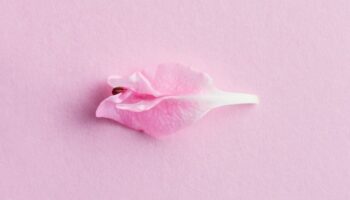Female ejaculation is expelling fluid from the opening of the female urethra during orgasm or arousal.
What’s the fluid expelled during female ejaculation?
Female ejaculate is a thick, milky fluid that’s rich in an enzyme called prostatic acid phosphate (PSA), just like semen. It also contains a small amount of fructose and the urea and creatinine found in urine. It doesn’t usually have an odor, but as it contains fructose it may taste a little sweet. Female ejaculate is different from the cervical fluid which lubricates the vagina when women are aroused.
The broadest definition of female ejaculation acknowledges women might also expel squirting fluid. This is a much thinner transparent fluid with a much higher concentration of urea and creatinine. It may be colorless or have a yellowish tinge, depending on the concentration of these elements. It sometimes also contains PSA.
How common is it?
It’s difficult to determine how common female ejaculation is, especially since for a long time, people didn’t differentiate between female ejaculation, squirting, and other sexual fluid release including incontinence.
Early research suggested as little as 4.6 percent or as many as 54 percent of women release fluid during orgasms. When considering the strictest definition of female ejaculation, the statistics may be even higher as many women wouldn’t know they’re expelling such a small amount of fluid, especially if it flows back into the bladder.
Sofie Roos, a licensed sexologist and writer for Passionerad, told Kinkly that it’s “kind of hard to predict how many women are having any form of liquid orgasm since many ejaculate without knowing, and neglect it for being wet or being ‘creamy,’ mainly because most women only know about the squirting orgasm and not about the female ejaculation. Based on my experience, around 10 to 15 percent of women squirt during sex, while another 10 to 15 percent have the ability to squirt from the right stimulation, even though they might never, or extremely rarely experience it. However, up to 50 percent of women most likely have a female ejaculation every now and then without paying any attention to it.”
Are there benefits?
As female ejaculation was only recently differentiated from other forms of female sexual fluid release, it’s difficult to determine what benefits, if any, it has.
A 2013 study found 78.8 percent of women and 90 percent of their partners felt female ejaculation had a positive impact on their sex lives. This study notes the ejaculate fluid is mostly clear, so subjects are likely reflecting on their experiences with squirting, rather than expelling ejaculate fluid.
Some scientists also believe that since female ejaculate contains PSA and fructose, ejaculating might help the sperm on its journey through the vagina and increase the risk of pregnancy. Other scientists dispute this theory, noting that the presence of urine components in ejaculate, especially squirting fluid, might actually kill sperm and make it less likely for women to conceive.
“There’s also some theories that the female ejaculation itself might reduce the risk of urinary tract infections, but the studies are too small to draw any safe conclusions,” Roos said.
She also acknowledged that while we’re still learning about female ejaculation and whether it has benefits, women who do ejaculate enjoy all the benefits that come with climaxing.
“Since the ejaculation always comes with an orgasm, you’re releasing the endorphins dopamine which makes you happy and satisfied, and oxytocin which makes you feel calm, safe and more in love (if having a partner), so female ejaculation gives major positive effects on your mental health,” she added. “And since squirters tend to climax more often than other women, they are exposed to more of these endorphins and might, for example, have a better chance to stand against depression or stress!”
What does female ejaculation feel like?
Some women and vagina owners say their orgasms don’t feel any different whether they ejaculate or not. Others say they feel warmth rising through their body and a tremor in their genitals when they ejaculate.
Roos said the sensations are “Almost like peeing, and many women who have been close to squirting ruin it because they think they will pee their pants since the fluid is released from the urethra. The fluid itself doesn't affect how good the orgasm feels per se (so having a G-spot orgasm can feel as good even if no fluid comes), but it can add to the orgasm since seeing yourself squirt or feeling yourself dripping can feel extremely sexy.”
Sexual techniques, positions, and arousal levels might also impact how ejaculation feels for some women.
How to ejaculate as a woman or AFAB person
As this phenomenon is a relatively new area of study, people are unsure how to trigger it. In a 2021 review of the existing literature, researchers said stimulating the G-spot might trigger female ejaculation. As the G-spot is up so high, some people find G-spot stimulation easiest with a partner or a curved vibrator. The jury’s still out on whether G-spot stimulation triggers female ejaculation, though. So, it’s worth experimenting with a range of stimulation, including vaginal and clitoral stimulation.
Relaxing rather than stressing about ejaculating can make climaxing easier. Women should also accept the sensations in their bodies, according to Roos.
“The most important step to get over to being able to squirt is to stop worrying about peeing yourself. It will feel exactly like you’re gonna pee, but the liquid won’t be concentrated urine (even though it contains it), but more of a diluted version of urine that’s clear and doesn't smell so much,” she said. “If you tense your Kegel muscles, you will never be able to squirt, so when the feeling of ‘Oh god, I will wet the bed’ comes, then keep relaxing, because that feeling means you’re super close!”
Women who’ve ejaculated before have a higher chance of understanding their bodies and knowing what it takes to ejaculate again. Anecdotal evidence also suggests women may be more likely to ejaculate during the window between ovulation and menstruation.



